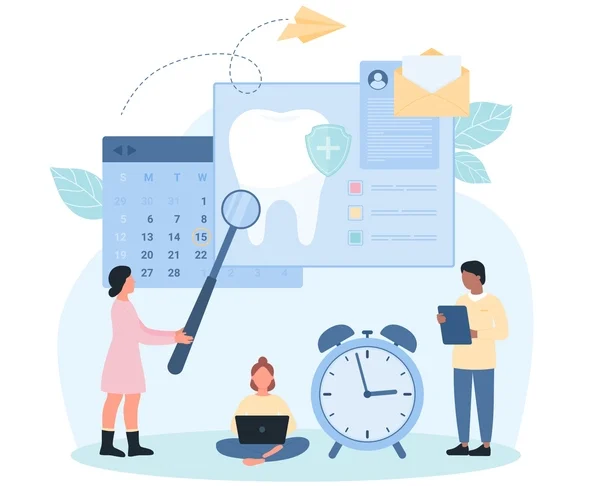Your appointment book is the backbone of your revenue engine. Inefficient scheduling system leads to lost income, underutilized staff, and frustrated patients. To increase revenue by 50%, one of the most impactful areas to improve is how you schedule and manage patient visits.
Table of Contents
ToggleEliminate Downtime
Every empty chair represents lost production. Even a single 30-minute gap in the schedule each day can cost your practice thousands of dollars annually. Here’s how to fill your schedule strategically:
1. Implement Real-Time Scheduling Tools
- Use cloud-based platforms that allow real-time visibility into your schedule.
- Offer online scheduling through your website and Google Business Profile; patients love the convenience, especially outside business hours.
- Ensure your system syncs with patient records, reminders, and mobile apps (e.g., Zocdoc, Weave, Solutionreach).
Stat: According to Dental Economics, practices using online scheduling see a 20–30% increase in new patient bookings.
2. Create a Short-Notice Fill List
Maintain a list of patients who:
- Want to be seen sooner
- Have flexible schedules
- Can come in on short notice
Use your automated system or front desk staff to contact these patients as soon as cancellations occur.
3. Reduce No-Shows and Last-Minute Cancellations
No-shows kill productivity. To minimize them:
- Send multiple reminders: 1 week, 2 days, and the day before via text/email.
- Confirm appointments by phone for high-value treatments.
- Charge a no-show fee (clearly stated in your policy) or offer a small incentive for on-time arrivals.
Tip: Keep track of chronic no-show patients. Consider requiring deposits for booking future appointments.
Maximize Chair Utilization
You may be “fully booked,” but if your chair time isn’t optimized, you’re losing money. Analyze how you use your operatory time — especially for your highest revenue-producing procedures.
1. Use Block Scheduling
Segment your day into strategic blocks:
- Reserve morning hours for complex or high-value procedures (crowns, implants, Invisalign).
- Leave mid-to-late afternoon for hygiene or quick appointments.
- Avoid randomly scattered procedures throughout the day.
Block scheduling helps control daily production and avoids burnout from back-to-back intensive procedures.
2. Strategically Expand Office Hours
Not all practices need to operate 7 days a week, but offering flexible scheduling options can attract more patients — especially busy professionals and families.
- Open early (7:00 AM appointments)
- Offer late hours (till 7:00 PM)
- Test one or two Saturdays per month
Pro Tip: Track the ROI of extended hours. If Saturday mornings generate $2,000 more per week, you could be looking at $100K+ in additional annual revenue.
Reduce Bottlenecks and Wait Times
Even when appointments are booked, delays in treatment flow reduce the number of patients you can see each day.
1. Streamline Check-In and Treatment Flow
- Use digital forms to collect patient history before they arrive.
- Pre-load rooms with instruments and supplies before appointments.
- Reduce handoffs or downtime between hygienist, assistant, and doctor.
Time-saving protocols add up over a week, allowing more patients to be seen without adding hours.
2. Analyze Time Per Appointment Type
How long does each procedure really take? Use your practice management software to:
- Track average time spent per type of visit
- Identify who runs behind and when
- Adjust your schedule accordingly (e.g., block 90 minutes for a crown instead of 60 if needed)
This reduces the domino effect of delays, keeping your entire day running smoothly.
Schedule for Production, Not Just Volume
Many practices chase the number of appointments rather than the value they bring. To grow revenue significantly, shift to production-based scheduling:
- Assign daily or weekly production goals to each provider.
- Mix hygiene, diagnostics, and high-value procedures strategically.
- Prioritize patients who have pending treatment plans.
Example: If you increase your average daily production per doctor by $500, and work 200 days/year, that’s $100,000 in added revenue.
Team Involvement in Scheduling
Your front office is not just answering phones — they’re revenue managers. Empower your team to:
- Identify and schedule higher-value procedures
- Spot underutilized times in the schedule
- Offer “same-day dentistry” options when time opens up
Incentivize scheduling efficiency by tying bonuses to filled schedules, low cancellation rates, or achieving daily production targets.
Use KPIs to Monitor Performance
Track these scheduling-related key performance indicators weekly:
- Chair Utilization Rate: % of operatory hours actually used
- No-Show Rate: Aim for <5%
- Production Per Hour: Are you trending upward over time?
- Avg. Appointment Value: Helps focus on high-margin procedures
- Cancellation Fill Rate: % of cancellations rebooked within 48 hours
Regularly review reports with your team to fine-tune your strategy.
Summary: Scheduling as a Revenue Lever
When optimized correctly, scheduling is not just about managing time — it becomes a powerful lever for growth. Reducing downtime, maximizing chair use, and focusing on high-value procedures can immediately increase production without needing more patients or expanding your team.
By combining smarter scheduling systems, team alignment, and performance monitoring, many practices can see a 10–20% revenue boost within 3–6 months — just by managing the calendar more effectively. When paired with the other growth strategies in this article, hitting that 50% revenue increase becomes not just possible, but predictable.

